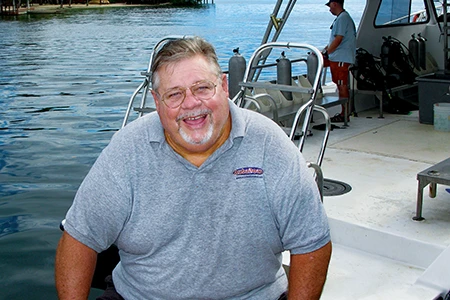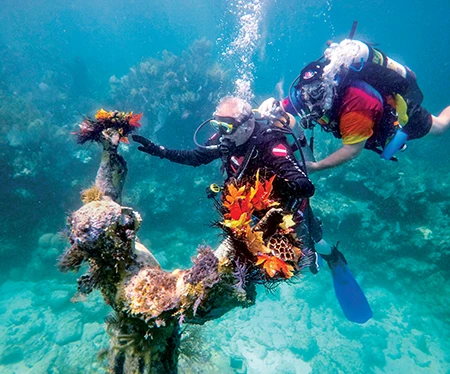MEMBER PROFILE
Hometown: Orlando, Florida
Age: 67
Years Diving: 55
Why I’m a DAN Member: I want to be a part of an organization that freely gives back to the dive community and ensures that I will be protected should I need DAN’s help.
When Pete Murray was 12 years old, Master Chief Petty Officer Williams at the Orlando Naval Base approached him and asked if he was “Murray’s kid,” referring to Major Daniel Murray. At that time, Pete’s dad was a recently deceased Marine helicopter pilot who had flown in the Korean War and World War II.
Williams credited Murray with saving his life, and his way of honoring Murray was by teaching his son to dive. It wasn’t your typical course. This class had no depth gauge, pressure gauge, or even an air bladder. There wasn’t even a certification card, which the younger Murray eventually got later. His training was old school, and he’s happy with all the improvements over the years.

Why did you want to scuba dive?
Like many divers who grew up in the 1960s, I saw Mike Nelson of Sea Hunt as a hero. One of the running jokes on ScubaBoard is, “What would Mike Nelson do?” I heard the call back then, and it’s been a nonstop adventure ever since.
A year and a half ago, you suffered a significant back injury and have recently completed major surgery. What motivates you to get back in the water?
The water calls to me. I was born in Barranquilla, Colombia, and my sister tells a story about me being 2 years old and swimming in a Colombian river. While growing up, I also canoed competitively, racking up more than 4,000 miles (6,437 kilometers), so the water has always been a part of who I am.
I can’t imagine a world where I am not in or on the water, which is why I live in Suwannee County, Florida, in the middle of cave country. The water also heals. DAN has been great at answering questions about what I can and can’t do. So far, it has all been can-do.


You’re known to many divers as The Chairman of ScubaBoard. Can you tell us how you came to run the world’s largest scuba diving forum and why you continue to invest in this resource for the community?
I joined ScubaBoard as User#853 in 2001, shortly after it was created. I was a network consultant at the time and chose the username NetDoc. When people learned about my profession, I was asked to help maintain the site and database. I acquired ScubaBoard in 2002, when the founder was ready to move on.
It was already an important resource for divers, new and old, and the community was set to grow. I took it to the next level and beyond to save it from becoming just another forum. More than 20 years later, the community has grown to more than 400,000 members, with new users joining daily.
I started getting asked questions early on that were better suited for DAN. I’m not a medical doctor — I could only fix ailing networks. I changed my username to remove any confusion, but many people still call me Net, Doc, NetDoc, and even Pete.
If you had one message that could benefit all divers, what would it be?
Can I give two? The first message is bringing meaning and challenge back to your diving by volunteering for organizations such as Diveheart. I have been a Diveheart volunteer and instructor for more than 20 years. It has been a real highlight and challenge in my diving.
Volunteering will give your diving a new purpose, and you get to blow bubbles at the same time. Even better, you’ll soon find that you’ll receive far more than whatever you’ve put in. It will challenge your trim, buoyancy, and situational awareness. You’ll have to worry about your buddy as well as yourself. Diveheart isn’t the only adaptive diving organization; you can contact them or any other agency like them.
The second message is to slow down — way down. It’s a big ocean out there, and you can’t see it all in one dive, so quit trying! Enjoy where you are and what you are doing, and stop worrying about missing out on the good stuff. Use missing something as an excuse to go later and see even more. Going slow means you need exceptional trim and buoyancy. The slower you go, the more you’ll need those skills.
Here’s a third message for free. Trim and buoyancy are closely tied, and the best teachers for those techniques frequently dive in caves. If you can close your eyes 12 inches (30 centimeters) off the bottom and maintain your relative position without kicking or sculling for a whole minute, you’ve done something most divers cannot do. If you can’t, you’ve got something to work on and might need help getting there.
Take a cave diving course from a fully cave-certified individual. They will help you take your trim and buoyancy to the next level, and you’ll use those skills to get a glimpse of a world most people don’t ever see.
You might even catch the bug, like I did, to dive in one hole, swim a mile, and exit from another. Of course, do that only after you’ve passed the appropriate classes, mastered the skills, and accumulated the experience. Do it with a friend you trust who has the same skills. It’s a blast!
© Alert Diver – Q4 2024